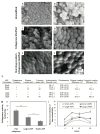Multifunctional albumin nanoparticles as combination drug carriers for intra-tumoral chemotherapy
- PMID: 23495216
- PMCID: PMC5720860
- DOI: 10.1002/adhm.201200467
Multifunctional albumin nanoparticles as combination drug carriers for intra-tumoral chemotherapy
Abstract
Current cancer therapies are challenged by weakly soluble drugs and by drug combinations that exhibit non-uniform biodistribution and poor bioavailability. In this study, we have presented a new platform of advanced healthcare materials based on albumin nanoparticles (ANPs) engineered as tumor penetrating, delivery vehicles of combinatorially applied factors to solid tumors. These materials were designed to overcome three sequential key barriers: tissue level transport across solid tumor matrix; uptake kinetics into individual cancer cells; therapeutic resistance to single chemotherapeutic drugs. The ANPs were designed to penetrate deeper into solid tumor matrices using collagenase decoration and evaluated using a three-dimensional multicellular melanoma tumor spheroid model. Collagenase modified ANPs exhibited 1-2 orders of magnitude greater tumor penetration than unmodified ANPs into the spheroid mass after 96 hours, and showed preferential uptake into individual cancer cells for smaller sized ANPs (<100 nm). For enhanced efficacy, collagenase coated ANPs were modified with two therapeutic agents, curcumin and riluzole, with complementary mechanisms of action for combined cell cycle arrest and apoptosis in melanoma. The collagenase coated, drug loaded nanoparticles induced significantly more cell death within 3-D tumor models than the unmodified, dual drug loaded ANP particles and the kinetics of cytotoxicity was further influenced by the ANP size. Thus, multifunctional nanoparticles can be imbued with complementary size and protease activity features that allow them to penetrate solid tumors and deliver combinatorial therapeutic payload with enhanced cancer cytotoxicity but minimal collateral damage to healthy primary cells.
Keywords: albumin nanoparticles; collagenase; drug delivery; tumor penetration.
Copyright © 2013 WILEY-VCH Verlag GmbH & Co. KGaA, Weinheim.
Figures





References
-
- Minchinton AI, Tannock IF. Nature Reviews Cancer. 2006;6:583. - PubMed
-
- Hambley TW. Cancer Research. 2009;69:1259. - PubMed
-
- Primeau AJ, Rendon A, Hedley D, Lilge L, Tannock IF. Clinical Cancer Research. 2005;11:8782. - PubMed
-
- Szakacs G, Paterson JK, Ludwig JA, Booth-Genthe C, Gottesman MM. Nature Reviews Drug Discovery. 2006;5:219. - PubMed
Publication types
MeSH terms
Substances
Grants and funding
LinkOut - more resources
Full Text Sources
Other Literature Sources

